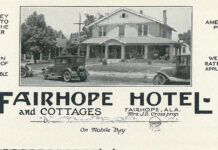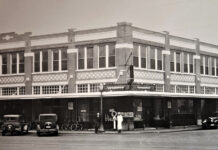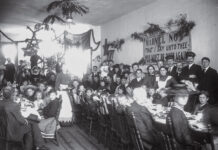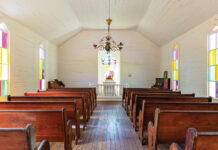Photos by Summer Ennis Ansley
Behind the Cathedral Basilica of the Immaculate Conception stands one of the most evocative buildings in Mobile — the Chighizola House. This elegant Greek Revival townhouse located at 6 South Franklin Street represents in brick and mortar a popular vision of 19th-century Mobile — urban, gracious and atmospheric. In name, architecture and preservation, the Chighizola House constitutes a unique survival in the present-day Henry Aaron Loop. A glance at the history of the building, an examination of its form and an exploration of its unaltered interiors provide a glimpse into worlds gone by and serve as a vehicle for continuing the revitalization of downtown Mobile.
The Chighizola House dates to the 1840s. Mobile was then experiencing its first “golden age.” The Port City was a large, cosmopolitan, wealthy community of 12,000 souls with multiple consulates and huge fortunes made of cotton. Barely 30 years prior, the town was a backward colonial garrison lacking in architectural charisma. By the 1840s, almost all physical expressions of the era were gone. Brick houses and stores not dissimilar to the Chighizola House were being constructed in their place and far beyond as Mobile grew and prospered. What lingered from the colonial epoch were families of Spanish descent. With the Eslavas, Espejos and Gonzales, the Chighizolas ranked among the most prominent of those tribes who remained in the Mobile after the American takeover in 1813. They became active and successful figures in the Port City’s thriving economy. Jacques Chighizola acquired the lot on which the house stands in 1824. Over the next 30 years, he would develop the property, along with numerous others in the area.
The Chighizola House is the least-altered and best-preserved building in the whole of Mobile.
In plan and elevation, Jacques Chighizola adopted a typology or form found across English and American cities: a side hall. In no way a misnomer, a side hall is a multi-story dwelling featuring a hall with rooms to one side. Many Mobilians refer to these houses as Federal houses. Very few of these houses were constructed in a Federal guise, the Chighizola House among them. In actuality, the house, like so many others that were built in Mobile during the period, was Greek Revival in guise. The large raked, battered or slanted enframement about the door is a case in point. What historians call an architrave, it is drawn from builder’s catalogs that were inspired by the main door to the Parthenon. The same construction appears throughout the interior. Popular in America since the 1820s, these and other Greek Revival motifs, such as six-over-six window light configurations and four-paneled doors, on the side hall plan imparted an international feel to the house. It could have been placed in New York, Boston or Philadelphia and been quite at home. Features like the small front lawn, pocket doors, high ceilings and ironwork are more Southern in flavor. The Chighizola House thus operated on multiple levels — national, regional and local.
Air of Elegance: The front parlor, with all it’s decay, features large six-over-six windows, an elegant fireplace and double pocket doors leading into the dining room. Plaster is peeling away from the original lath, where horsehair sticks out of the
plaster cement.
All in the Details: The ceiling of the main parlor (right) still boasts its stenciled borders and decoration in pink, gold and burgundy. Rogers plans to copy the pattern back onto a restored ceiling. Wallpaper (opposite page), presumably from the late 1800s, peels from every wall. The original shutters (page 61) still bear their first coat of paint.
Mobile once had scores of side-hall dwellings. The vast majority of these buildings that defined the appearance and experience of the city have been demolished. The Chighizola House is not only the least altered extant example of the type but also the best-preserved building in the whole of Mobile. The house, the huge service wing, the floor plan and the fitting are all intact. The service wing is one of the largest in Mobile. Original finishes survive in those spaces, save small alterations that were made shortly after the house’s construction. From the presence of closets, choices of paint color and unaltered placement of doors, much can be gleaned as to how 19th-century Mobilians thought, entertained and simply lived their daily lives.
The Chighizola House has long been both a source of pride and worry for Downtown enthusiasts and preservationists. The venerable old building’s amazingly unaltered state could have been its downfall. Many Mobile buildings in similar condition have burned or been demolished. Luckily, the Chighizola House has a very bright future ahead of it. The building was purchased from the estate of longtime owners by Historic Mobile LLC, a wholly-owned subsidiary of Main Street Mobile. It is now under contract with seasoned contractors and Downtown redevelopers Cay and Mike Rogers. With such notable historic restorations as the Buick Building on Saint Louis Street under his belt, Mike knows well the ins and outs of working with an older building, as well as the various historical entities over-seeing them. “Preserving the original character of historic buildings is crucial for maintaining the cultural identity of our city,” Mike declares. “With the Chighizola House project, our focus is on preserving the authenticity and charm of this historic building. We’re committed to minimal alterations to the original layout, allowing the building to tell its story as accurately as possible while contributing to the revitalization of downtown Mobile. Using this approach, we’re not just renovating a building; we’re safeguarding a piece of Mobile’s past for generations to come.” Remarkably, Mike has unearthed a fascinating familial link to the Chighizolas. This seemingly serendipitous connection, spanning generations both past and present, adds an enchanting layer of significance to his family heritage.
A wing of rooms: A hodgepodge of wood and windows from the early 1900s enclosed — and protected — service wings with four rooms on each of two stories that might have housed anything from food staples to unmarried sons to enslaved people. Some of the rooms feature elegant fireplaces, while others are plain and windowless.
The Vision: Contractors Cay and Mike Rogers are working with others to restore the well-preserved house and help it find a new future.
Photo on the right by Chad Riley
In association, appearance and state, the Chighizola House represents the multivalent nature of historic preservation in Mobile. The Port City has a glorious past. A single building can represent and embrace so much of early epochs, all the while serving as a conduit for future growth and quality of life. The old Mobile brick walls, pocket doors, and unaltered rooms of the Chighizola House will soon benefit from a balanced approach of continued preservation, thorough restoration and necessary rehabilitation. The results will allow present and future generations of Mobilians to have a glimpse into the city’s past while being a major step forward in the ongoing Downtown revitalization.
UPDATE: The Chighizola House will be renovated and showcased as one of Mobile Bay Magazine’s upcoming Inspiration Homes! Follow @mbinspirationhome on Instagram for renovation updates and stay tuned for tour information.















